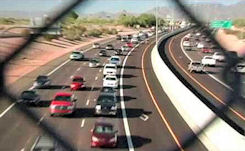Outdated HOV Lanes
On Page B2 of the City & Region section of the October 17th Boston Sunday Globe,
it was reported that , ďThe HOV lane {on Rte I-93 South} will connect to a new add-lane
on the {Zakim} bridge, allowing HOV traffic to continue straight into the southbound tunnel,
according to Big Dig and Massachusetts Turnpike Authority spokesman Doug Hanchett.Ē
A thoughtless traffic solution
So, here I am, driving north on a major interstate road in Massachusetts at 5 PM on a workday.
Iím in the right hand travel lane, approaching the turnoff to another major interstate highway
that I want to take. Iím doing 65 MPH when I notice several cars passing me on the right in the
breakdown lane. Are these people crazy? Donít they know itís illegal to drive in the breakdown lane?
But wait, I see a sign that says itĎs OK to drive in the breakdown lane during the evening rush hour.
The drivers of the cars in the breakdown lane that are passing me may not be all that crazy but
the people who came up with this idea must be. What is the breakdown lane for in the first place?
My uneducated guess is that itís for vehicles that break down, i.e., vehicles that are unable to go
and their drivers have pulled over into the breakdown lane to wait for assistance. How would you like
to be sitting in your car waiting for a tow truck with a car or truck bearing down on you at 70 MPH?
Have you ever had a flat tire on the road and pulled over to change the tire? How would you feel,
looking up and seeing someone coming straight at you at 70 MPH?
I can relate to this problem since I had a car totaled in a similar situation. My wife had gone shopping
at a greater Boston Shopping Mall. She was returning on one of the major highways north of Boston when
the car stopped running. There was no breakdown lane, but she pulled over to the right of the road.
A good Samaritan stopped and helped push the car onto the shoulder of the road. My wife then went to
call for road assistance and called the police to inform them of the stalled-out car. By then the car
had been rear ended and totaled. Fortunately, no one was in my car when it was struck and the people
in the other car were uninjured. Had my wife stayed in the car or been standing beside the car,
the results could have been very different.
Getting back to my drive north, let me say that itís very disconcerting getting ready to make a
right turn from the right hand travel lane when there are vehicles passing me on the right at
high speed in the breakdown lane. But, at least I am in a moving car with a reasonable chance
of avoiding these vehicles. When you are stuck in the breakdown lane, you donít get this chance.
Travel in breakdown lanes is also permitted on highways during construction or in emergencies.
In these cases, however, the situation is temporary and is usually unavoidable. Even then, it
would be prudent to limit the speed of vehicles in the breakdown lane, and this reduction in
speed is frequently accomplished by the Police or by the road conditions at the site.
But, the practice of allowing full speed travel in the breakdown lanes of a major high-speed
highway during rush hour is simply a tragedy waiting to happen. Yes, it does increase the
capacity of the highway, but at the potential cost of death and injury. Wouldnít it better
to bite the bullet and spend the money to widen the highway? How many tragedies will it take to stop
this practice? In order to avoid the chances of killing or injuring people, isnít a slightly
longer commute to or from work preferable?
†
†













